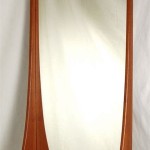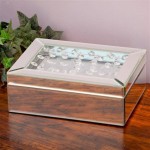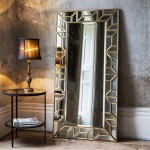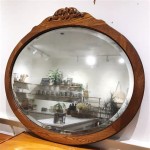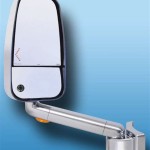Can a Mirror Be Placed Facing South? Exploring the Considerations
The placement of mirrors within a living space is often dictated by aesthetic preferences, practical considerations of lighting and space enhancement, and, in some cases, adherence to specific belief systems such as Feng Shui or Vastu Shastra. The question of whether a mirror can be placed facing south is multifaceted and warrants examination from various angles, including practical implications related to light and aesthetics, as well as potential influences from traditional belief systems. This article aims to explore the different aspects of this question, providing a comprehensive understanding of the factors involved in determining the suitability of placing a mirror facing south.
Mirrors, by their reflective nature, influence the perception of space, the distribution of light, and the overall ambiance of a room. A mirror placed strategically can visually enlarge a small room, brighten a dark corner, or highlight a particular architectural feature. Conversely, a poorly placed mirror can create unwanted reflections, distort the spatial perception, and contribute to a sense of unease. Therefore, careful consideration must be given to the orientation of a mirror to ensure it serves its intended purpose effectively.
From a purely practical standpoint, the suitability of placing a mirror facing south depends on several factors, including the room's layout, the presence of windows and other light sources, and the desired effect. In some situations, a south-facing mirror might be beneficial, while in others, it could create undesirable consequences. The orientation of a room and its exposure to sunlight are primary elements in evaluating the impact of a mirror's placement.
Considering the Impact of Sunlight and Natural Light
The most critical aspect to consider when deciding to place a mirror facing south is the potential impact of sunlight and natural light. A south-facing mirror will reflect the incoming sunlight, which can be beneficial in certain circumstances. For instance, in a room that receives limited natural light, a south-facing mirror can significantly brighten the space by reflecting the available sunlight and distributing it more evenly. This can be particularly useful during the winter months when daylight hours are shorter and natural light is scarce.
However, the intensity of sunlight can also be a drawback. Direct sunlight reflected by a large south-facing mirror can cause glare, which can be uncomfortable and even potentially harmful to the eyes. Furthermore, excessive reflected sunlight can lead to increased heat within the room, potentially raising energy consumption for cooling. It is crucial to assess the intensity and duration of sunlight exposure before installing a south-facing mirror to prevent such negative effects.
The presence of window treatments, such as blinds, curtains, or solar films, can mitigate the potential drawbacks of a south-facing mirror. These treatments can control the amount of sunlight entering the room, reducing glare and heat gain while still allowing some natural light to be reflected. The choice of window treatment should be carefully considered to strike a balance between maximizing natural light and minimizing unwanted side effects.
Another factor to consider is the size and shape of the mirror. A small, strategically placed mirror may not reflect enough sunlight to cause significant glare or heat gain, while a large mirror spanning an entire wall could amplify these effects. Similarly, the shape of the mirror can influence the distribution of reflected light. A flat mirror will reflect light in a straight line, while a curved mirror can disperse light more widely. Therefore, the size and shape of the mirror should be chosen in relation to the room's orientation, the intensity of sunlight, and the desired lighting effect.
Aesthetic Considerations and Interior Design Principles
Beyond practical considerations related to light and heat, the placement of a mirror also has significant aesthetic implications. Mirrors can be used to create illusions of space, enhance architectural features, and add visual interest to a room. A south-facing mirror can be strategically placed to reflect a pleasing view, such as a garden or a scenic landscape, thereby bringing the outdoors inside and enhancing the room's ambiance.
However, it is equally important to consider what the mirror will be reflecting. A south-facing mirror that reflects an unattractive view, such as a cluttered storage area or a blank wall, can detract from the room's aesthetic appeal. In such cases, alternative mirror placements or decorative accents may be more suitable. The surrounding decor, including furniture and artwork, should also be taken into account to ensure the mirror complements the overall design scheme.
The style and frame of the mirror can also contribute to the room's aesthetic. A decorative mirror frame can add a touch of elegance or sophistication, while a minimalist frame can create a more contemporary look. The choice of frame should be consistent with the room's overall design style. The size and shape of the mirror should also be proportionate to the surrounding furniture and architectural features.
Mirrors can also be used to highlight specific architectural features, such as a fireplace, a decorative molding, or a unique piece of furniture. A south-facing mirror placed strategically can draw attention to these features, adding depth and visual interest to the room. However, it is important to avoid creating a cluttered or unbalanced look. The goal is to enhance the room's aesthetic appeal, not to overwhelm it with excessive reflections.
Examining Feng Shui and Vastu Shastra Perspectives
In addition to practical and aesthetic considerations, the placement of mirrors can also be influenced by traditional belief systems such as Feng Shui and Vastu Shastra, which emphasize the importance of energy flow and spatial harmony. While these systems differ in their specific recommendations, they both offer guidelines for mirror placement based on principles of energy balance and spatial alignment.
In Feng Shui, the south is often associated with fame, recognition, and reputation. Placing a mirror facing south is generally discouraged as it is believed to reflect and potentially diminish the energy associated with these aspects of life. Instead, Feng Shui practitioners often recommend placing mirrors in areas that require amplification of energy, such as dining areas or areas associated with wealth and abundance.
However, the application of Feng Shui principles is not always straightforward, and the specific recommendations can vary depending on the individual's birth chart and the overall energy map of the space. In some cases, a south-facing mirror might be acceptable if it reflects a positive and auspicious view, such as a lush garden or a calm body of water. The key is to ensure that the reflected image enhances the energy of the space rather than diminishing it.
Vastu Shastra, an ancient Indian system of architecture and design, also provides guidelines for mirror placement. In Vastu, the south is generally considered an inauspicious direction for mirrors, as it is associated with negative energies and obstacles. Vastu principles often suggest placing mirrors on the north or east walls to reflect positive energies and promote health, wealth, and prosperity.
Similar to Feng Shui, Vastu Shastra emphasizes the importance of considering the specific context of the space. The size, shape, and placement of the mirror should be carefully evaluated to ensure it aligns with the overall energy flow of the environment. Consulting with a qualified Vastu consultant can help determine the optimal mirror placement based on the specific characteristics of the building and the occupants' needs.
In conclusion, the decision of whether to place a mirror facing south requires a careful evaluation of various factors, including practical considerations related to sunlight and natural light, aesthetic principles of interior design, and potential influences from traditional belief systems such as Feng Shui and Vastu Shastra. A thorough assessment of these factors will help determine the suitability of a south-facing mirror in a particular space and ensure that its placement contributes to a harmonious and aesthetically pleasing environment.

Mirror Vastu Right Direction Of In Homes And Offices

Mirror Positioning According To Vastu Shastra A Brief Understanding

The Feng Shui Of Mirror Placement In Your Bedroom City Mattress

Mirror Vastu Right Direction Of In Homes And Offices

𝐌𝐢𝐫𝐫𝐨𝐫 𝐕𝐚𝐬𝐭𝐮 Which Mirror Direction Is Best For Home Office

Mirror Vastu Right Direction Of In Homes And Offices

5 Mirror Vastu Placement Tips For A Happy Home Livspace

21 Feng Shui Mirror Placement Rules And Tips For Your Home Fengshuinexus

Vastu For Mirror Direction Positions Mirrors In Bedroom

Place Mirror As Per Vastu And Note The Effect Astro Prediction Astrology Onmanorama Wealth Well Being Health House Home

